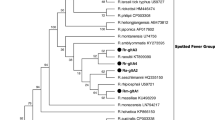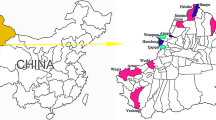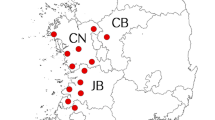Abstract
Tick-borne rickettsioses, most of them belonging to the spotted fever group (SFG), have been recognized as important emerging vector-borne zoonotic diseases. In order to determine the presence of Rickettsia spp. in questing ticks from north-western Spain, 1056 Ixodes ricinus, 19 Dermacentor marginatus, 17 Dermacentor reticulatus and one Ixodes acuminatus were processed. Rickettsia DNA was detected by PCR targeting rOmpA and rOmpB genes. A total of 219 (20.7%) I. ricinus, 19 (100%) D. marginatus and four D. reticulatus (23.5%) were positive. The prevalence was significantly higher in I. ricinus from coastal areas and in winter. Five species were identified: Rickettsia felis, Rickettsia monacensis, Rickettsia raoultii, Rickettsia slovaca and “Candidatus Rickettsia rioja”. Our results reveal a significant presence of some pathogenic Rickettsia species in questing tick populations from this area which involves a noticeable risk of rickettsiosis. As R. raoultii, R. slovaca and “Ca. R. rioja” DNA were identified in I. ricinus, considered an unusual vector for these Rickettsia species, further studies are needed to unravel the role of that tick species in the maintenance and transmission of these three Rickettsia species in north-western Spain.
Similar content being viewed by others
References
Barandika JF, Hurtado A, García-Sanmartin J, Juste RA, Anda P, García-Perez AL (2008) Prevalence of tick-borne zoonotic bacteria in questing adult ticks from northern Spain. Vector Borne Zoonotic Dis 8:829–835
Boldis V, Spitalska E (2010) Dermacentor marginatus and Ixodes ricinus ticks versus L929 and Vero cell lines in Rickettsia slovaca life cycle evaluated by quantitative real time PCR. Exp Appl Acarol 50:353–359
Burri C, Dupasquier C, Bastic V, Gern L (2011) Pathogens of Emerging Tick-Borne Diseases, Anaplasma phagocytophilum, Rickettsia spp., and Babesia spp., in Ixodes ticks collected from rodents at four sites in Switzerland (Canton of Bern). Vector Borne Zoonotic Dis 11:939–944
Chmielewski T, Podsiadly E, Karbowiak G, Tylewska-Wierzbanowska S (2009) Rickettsia spp. in ticks, Poland. Emerg Infect Dis 15:486–488
Choi YJ, Lee SH, Park KH, Koh YS, Lee KH, Baik HS et al (2005) Evaluation of PCR-based assay for diagnosis of spotted fever group rickettsiosis in human serum samples. Clin Diagn Lab Immunol 12:759–763
Dautel H, Dippel C, Oehme R, Hartelt K, Schettler E (2006) Evidence for an increased geographical distribution of Dermacentor reticulatus in Germany and detection of Rickettsia sp. RpA4. Int J Med Microbiol 296:149–156
Dobec M, Golubic D, Punda-Polic V, Kaeppeli F, Sievers M (2009) Rickettsia helvetica in Dermacentor reticulatus ticks. Emerg Infect Dis 15:98–100
Dobler G, Wolfel R (2009) Typhus and other rickettsioses emerging infections in Germany. Dtsch Arztebl Int 106:348–354
Elfving K, Olsen B, Bergstrom S, Waldenstrom J, Lundkvist A, Sjostedt A et al (2010) Dissemination of spotted fever rickettsia agents in Europe by migrating birds. PLoS ONE 5:e8572
Estrada-Peña A, de la Fuente J (2014) Toward a multidisciplinary approach to the study of tick-borne diseases. Front Cell Infect Microbiol 4:118
Fernández de Mera IG, Ruíz-Fons F, de la Fuente G, Mangold AJ, Gortázar C, de la Fuente J (2013) Spotted fever group rickettsiae in questing ticks, Central Spain. Emerg Infect Dis 19:1163–1165
Floris R, Yurtman AN, Margoni EF, Mignozzi K, Boemo B, Altobelli A et al (2008) Detection and identification of Rickettsia species in the northeast of Italy. Vector Borne Zoonotic Dis 8:777–782
Ibarra V, Portillo A, Santibáñez S, Blanco JR, Pérez-Martinez L, Márquez J et al (2005) DEBONEL/TIBOLA—is Rickettsia slovaca the only etiological agent? Rickettsioses: from genome to proteome, pathobiology, and Rickettsiae as an international threat. Ann N Y Acad Sci 1063:346–348
Jado I, Oteo JA, Aldámiz M, Gil H, Escudero R, Ibarra V et al (2007) Rickettsia monacensis and human disease, Spain. Emerg Infect Dis 13:1405–1407
Labruna MB, Whitworth T, Bouyer DH, McBride J, Camargo LMA, Camargo EP et al (2004) Rickettsia bellii and Rickettsia amblyommii in Amblyomma ticks from the State of Rondonia, Western Amazon, Brazil. J Med Entomol 41:1073–1081
Márquez FJ (2008) Spotted fever group Rickettsia in ticks from southeastern Spain natural parks. Exp Appl Acarol 45:185–194
Márquez FJ, Millán J (2009) Rickettsiae in ticks from wild and domestic carnivores of Doñana National Park (Spain) and surrounding area. Clin Microbiol Infect 15:224–226
May K, Strube C (2014) Prevalence of Rickettsiales (Anaplasma phagocytophilum and Rickettsia spp.) in hard ticks (Ixodes ricinus) in the city of Hamburg, Germany. Parasitol Res 113:2169–2175
Milhano N, Lopes de Carvalho I, Alves AS, Arroube S, Soares J, Rodriguez P, Carolino M, Núncio MS, Piesman J, de Sousa R (2010) Coinfections of Rickettsia slovaca and Rickettsia helvetica with Borrelia lusitaniae in ticks collected in a Safari Park. Portugal. Ticks Tick-borne Dis 1(4):172–177
Oteo JA, Portillo A (2012) Tick-borne rickettsioses in Europe. Ticks Tick Borne Dis 3:270–277
Oteo JA, Ibarra V, Blanco JR, Martínez de Artola V, Márquez FJ, Portillo A, Raoult D, Anda P (2004) Dermacentor-borne necrosis erythema and lymphadenopathy: clinical and epidemiological features of a new tick-borne disease. Clin Microbiol Infect 10(4):327–331
Oteo JA, Portillo A, Santibáñez S, Pérez-Martínez L, Blanco JR, Jiménez S et al (2006) Prevalence of spotted fever group Rickettsia species detected in ticks in La Rioja, Spain. Ann N Y Acad Sci 1078:320–323
Otranto D, Dantas-Torres F, Giannelli A, Latrofa MS, Cascio A, Cazzin S et al (2014) Ticks infesting humans in Italy and associated pathogens. Parasit Vectors 14:328
Palomar AM, Portillo A, Mazuelas D, Roncero L, Arizaga J, Crespo A et al (2016) Molecular analysis of Crimean-Congo hemorrhagic fever virus and Rickettsia in Hyalomma marginatum ticks removed from patients (Spain) and birds (Spain and Morocco), 2009–2015. Ticks Tick Borne Dis 7:983–987
Parola P (2011) Rickettsia felis: from a rare disease in the USA to a common cause of fever in sub-Saharan Africa. Clin Microbiol Infect 17:996–1000
Parola P, Raoult D (2001) Tick-borne bacterial diseases emerging in Europe. Clin Microbiol Infect 7:80–83
Parola P, Paddock CD, Socolovschi C, Labruna MB, Mediannikov O, Kernif T et al (2013) Update on tick-borne rickettsioses around the world: a geographic approach. Clin Microbiol Rev 26:657–702
Paules CI, Marston HD, Bloom ME, Fauci AS (2018) Tickborne diseases—confronting a growing threat. N Engl J Med 379:701–703
Pérez-Eid C (2007) Les tiques. Identification, biologie, importance médicale et vétérinaire. Lavoisier TEC & DOC, Paris
Petney TN, Pfäfffie MP, Skuballa JD (2012) An annotated checklist of the ticks (Acari: Ixodida) of Germany. Syst Appl Acarol 17:115–170
Portillo A, Ibarra V, Santibáñez S, Pérez-Martinez L, Blanco JR, Oteo JA (2009) Genetic characterisation of ompA, ompB and gltA genes from Candidatus Rickettsia rioja. Clin Microbiol Infect 15:307–308
Portillo A, Santibáñez S, García-Álvarez L, Palomar AM, Oteo JA (2015) Rickettsioses in Europe. Microbes Infect 17:834–838
R Core Team (2018) R: A Language and Environment for Statistical Computing. https://www.R-project.org/
Regnery RL, Spruill CL, Plikaytis BD (1991) Genotypic identification of Rickettsiae and estimation of intraspecies sequence divergence for portions of 2 rickettsial genes. J Bacteriol 173:1576–1589
Remesar S, Díaz P, Venzal JM, Pérez-Creo A, Prieto A, Estrada-Peña A et al (2019) Tick species diversity and population dynamics of Ixodes ricinus in Galicia (north-western Spain). Ticks Tick Borne Dis 10:132–137
Reye AL, Stegniy V, Mishaeva NP, Velhin S, Hubschen JM, Ignatyev G et al (2013) Prevalence of tick-borne pathogens in Ixodes ricinus and Dermacentor reticulatus ticks from different geographical locations in Belarus. PLoS ONE 8:e54476
Rizzoli A, Silaghi C, Obiegala A, Rudolf I, Hubálek Z, Földvári G et al (2014) Ixodes ricinus and its transmitted pathogens in urban and peri-urban areas in Europe: new hazards and relevance for public health. Front Public Health 1:251
Roux V, Fournier PE, Raoult D (1996) Differentiation of spotted fever group rickettsiae by sequencing and analysis of restriction fragment length polymorphism of PCR-amplified DNA of the gene encoding the protein rOmpA. J Clin Microbiol 34:2058–2065
Santibáñez S, Portillo A, Santibáñez P, Palomar AM, Oteo JA (2013) Usefulness of rickettsial PCR assays for the molecular diagnosis of human rickettsioses. Enferm Infecc Microbiol Clin 31:283–288
Santibáñez S, Portillo A, Palomar AM, Santibáñez P, Oteo JA (2017) Rickettsia spp. detected in Dermacentor marginatus from DEBONEL/TIBOLA/SENLAT patients. ESCCAR-ASR Joint meeting. International congress on Rickettsiae and other intracellular bacteria. Marseille, France. P1-20
Selmi M, Ballardini M, Salvato L, Ricci E (2017) Rickettsia spp. in Dermacentor marginatus ticks: analysis of the host-vector-pathogen interactions in a northern Mediterranean area. Exp Appl Acarol 72:79–91
Silaghi C, Hamel D, Thiel C, Pfister K, Pfeffer M (2011) Spotted Fever Group Rickettsiae in ticks, Germany. Emerg Infect Dis 17:890–892
Špitalská E, Štefanidesová K, Kocianová E, Boldiš V (2012) Rickettsia slovaca and Rickettsia raoultii in Dermacentor marginatus and Dermacentor reticulatus ticks from Slovak Republic. Exp Appl Acarol 57(2):189–197
Spitalska E, Boldis V, Derdakova M, Selyemova D, Taragel’ova VR (2014) Rickettsial infection in Ixodes ricinus ticks in urban and natural habitats of Slovakia. Ticks Tick Borne Dis 5:161–165
Stanczak J, Biernat B, Racewicz M, Zalewska M, Matyjasek A (2018) Prevalence of different Rickettsia spp. in Ixodes ricinus and Dermacentor reticulatus ticks (Acari: Ixodidae) in north-eastern Poland. Ticks Tick Borne Dis 9:427–434
Svehlova A, Berthova L, Sallay B, Boldis V, Sparagano OAE, Spitalska E (2014) Sympatric occurrence of Ixodes ricinus, Dermacentor reticulatus and Haemaphysalis concinna ticks and Rickettsia and Babesia species in Slovakia. Ticks Tick Borne Dis 5:600–605
Tijsse-Klasen E, Jameson LJ, Fonville M, Leach S, Sprong H, Medlock JM (2011) First detection of spotted fever group rickettsiae in Ixodes ricinus and Dermacentor reticulatus ticks in the UK. Epidemiol Infect 139:524–529
Toledo A, Olmeda AS, Escudero R, Jado I, Valcárcel F, Casado-Nistal MA et al (2009) Tick-borne zoonotic bacteria in tickscollected from Central Spain. Am J Trop Med Hyg 81:67–74
Acknowledgements
This research was supported by the Programme for Consolidating and Structuring Competitive Research Groups (GRC2015/003; Xunta de Galicia, Spain) and by a predoctoral grant (European Social Fund, Secretaría Xeral de Universidades, Xunta de Galicia, Spain).
Author information
Authors and Affiliations
Corresponding author
Ethics declarations
Conflict of interest
The authors declare that they have no conflict of interest.
Additional information
Publisher's Note
Springer Nature remains neutral with regard to jurisdictional claims in published maps and institutional affiliations.
Electronic supplementary material
Below is the link to the electronic supplementary material.
Rights and permissions
About this article
Cite this article
Remesar, S., Díaz, P., Portillo, A. et al. Prevalence and molecular characterization of Rickettsia spp. in questing ticks from north-western Spain. Exp Appl Acarol 79, 267–278 (2019). https://doi.org/10.1007/s10493-019-00426-9
Received:
Accepted:
Published:
Issue Date:
DOI: https://doi.org/10.1007/s10493-019-00426-9




